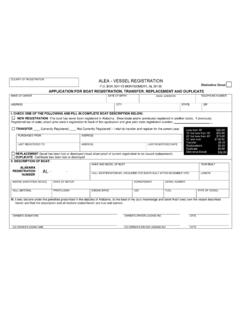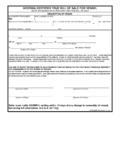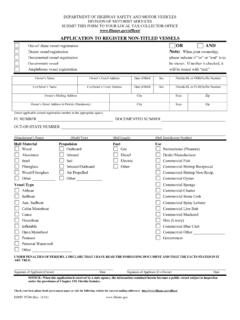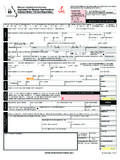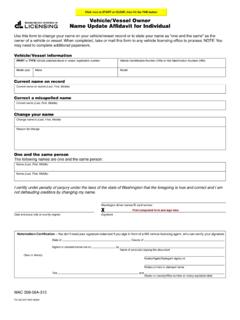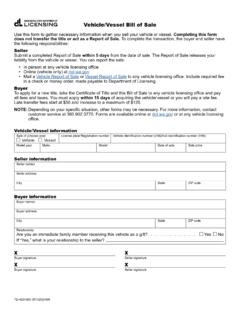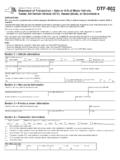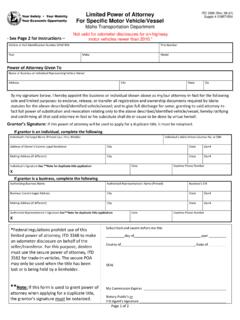Transcription of Pressure Vessel Engineering Ltd. provides: ASME Vessel ...
1 Pressure Vessel Engineering Ltd. provides: ASME Vessel Code Calculations - Finite Element Analysis (FEA) - Solid Modeling / Drafting - Canadian registration Number (CRN) Assistance Disclaimer: This document is provided for educational purposes only. Pressure Vessel Engineering Ltd. is not liable for its use. Loads on Flanges - The ASME Way ASME VIII-1 Appendix 2 provides a method of sizing flanges. The calculations use three loads - HT, HG & HD and two operating conditions - seating and operating. What are these loads, how are they calculated, and where are they applied to the flange? A sample flange shown below will be calculated using ASME Appendix 2 methods and by finite element analysis (FEA) to illustrate the application of the loads and show the resulting stresses.
2 Sample flange (App 2 Fig 2-4(5) Sample Flange Dimensions Inside Diameter = B = Outside Diameter = A = 22 Thickness = t = Hub radius = r = Pipe thickness = g0 = Gasket OD = Gasket ID = Gasket m = 3 Gasket y = 10,000 16 Bolts x 1 dia on a BCD (C) rLoads on - Page 2 of 16 Sample flange - the FEA model Flange Model 16 holes on BCD, 1 bolt size - only 1/2 of one bolt will be used for the FEA model due to symmetry. Loads on - Page 3 of 16 Half of the 1 bolt is added. A mirrored body creates a flanged pair. For FEA the bolt length is cut on the center of the gasket. The gasket is removed and is replaced by the loads it generates. Split lines can be seen where the gasket loads HT and HG are applied. Gasket Gasket Loads sLoc Loads on - Page 4 of 16 Load HD - Operating HD is created by the Pressure on the pipe attached to the flange.)
3 Force = Pressure x Area. HD = P * B^2 / 4 The load is generated on center line of the pipe, but the ASME rules change the moment arm depending on the attachment method. When FEA is performed, the load should be applied to the attached pipe - the FEA program will determine how the load is distributed. Loads on - Page 5 of 16 Load HT - Operating HT is created by the internal Pressure acting on the gasket: 1) Pressure is applied to the exposed edge of the gasket 2) The gasket tries to expand but is held in place by the flange faces 3) The flange faces push back The force between the gasket and the flange is shown as a triangle. The force is zero at the OD of the gasket (there is no Pressure at the gasket OD and thus no leakage). At the inside edge, the Pressure is the Pressure in the pipe.
4 HT is the average Pressure along the length. mhT is measured at the point 1/3 up the triangle, the centroid of the force. The ASME rules reduce the width of the gasket. This load is a design rule, not a predictor of actual flange stresses. For FEA analysis, the load HT is applied at the moment arm mhT away from the bolt centerline. Loads on - Page 6 of 16 Load HG - Operating HG operating is the force required to keep the flange sealed against the operating Pressure . It is generated by tightening the bolts. Load = effective area x gasket factor m x Pressure . If the flange is self energizing (does not need additional force to seal such as an o-ring) then HG operating = 0 Load HG operates through the center of the gasket, but the gasket size is reduced by the ASME rules to create an effective area.
5 Correlation to real gasket properties is difficult - this load and its moment arm is a design rule, not a predictor of actual flange stresses. Loads on - Page 7 of 16 Load HG - Seating HG seating is the force required to seat the gasket into the flange gasket face and be leak tight against a Pressure of 0 psi. (HG operating provides the load required to keep the seal as the operating Pressure is increased). The force HG is loosely based on gasket physical properties, but the gasket area used is modified (reduce) from the actual gasket width because the code y factors are too high. Correlation to real gasket properties is impossible - this load and its moment arm are a design rule, not a predictor of actual flange stresses. Force HG has an additional load added to it - the gasket destroying or gasket crushing force.
6 The computed seating load on the gasket is increased to the average of the required bolt strength and the available bolt strength. This code disaster greatly increases the required thickness of flanges far beyond the loads that the gasket can handle. As a designer, when the seating loads are too large and are caused by extra bolt area, several options are available: 1) make the bolts smaller in diameter or fewer in number. Reducing the effective area of the bolts reduces this theoretical gasket crushing force. 2) use weaker bolts - same idea as above. 3) if material waste and cost are no object, make the flange thicker. This route often is used when a custom appendix 2 flange must mate up to standard flanges such as series which seldom calculate to appendix 2 rules. Loads on - Page 8 of 16 ASME Loads Applied to the FEA Model The flange model with the HD, HG and HT loads applied.
7 Combined operating and seating stresses case stresses. Higher stresses can be seen at the pipe to flange discontinuity. Bending stresses can also be seen in the bolt. Although the stresses look high compared with the 20,000 psi membrane allowable stress for the flange and pipe, the stresses are minor if compared with a local discontinuity limit of 3x20,000 psi. This flange design although loaded to the maximum ASME allows can be considered to be lightly loaded and wasteful of materials. HD HG operating + HG seating HT Loads on - Page 9 of 16 Operating loads only - used for cycle life calculations (seating HG is removed). The gasket gets seated once, this is the load that the flange sees with each application and removal of Pressure . The flange loads are extremely light for this flange that was designed around the gasket seating case.
8 Loads on - Page 10 of 16 The Effective Seating Width of the Gasket The effective seating width of the gasket removes the correlation between the physical properties of the gasket material, and the calculated gasket loads. The seating width is typically 1/2 * the square root of the actual gasket width (see table for actual formulas which vary depending on the gasket seating arrangement and the gasket width). Traditionally, this was done to allow for rotation of the flanges under load which reduced the actual width of the gasket in contact with the flange faces (it was presumed that the inside edge of the gasket was not in contact). In reality, the ASME rules, including the flange rotation limits in 2-14, do not allow enough flange rotation for the gasket to be partially in contact.
9 This effective width calculation removes any possible correlation between ASME flange calculation methods and flange manufacturers provided m and y values. It was probably introduced because the table gasket factors are too high. The seating and operating loads are design rules and should not be expected to predict actual flange stresses. They can be used in FEA analysis to simulate loads in a manner similar to App 2 methods as required by U-2(g). Width b0 = Width/2 *sqrt(b0) Effective Width Effective width for a common gasket arrangement - Table sketches (1a) and (1b) Loads on - Page 11 of 16 Effective Gasket WidthEffective Widthb0 = *sqrt(b0)Effective Width Attachments Attached are calculation sheets for: - ASME code calculation for this flange.
10 This flange is limited by the seating case - in this case seating of a high strength spiral wound gasket - m=3, y = 10,000. - FEA loads for the operating and seating case - FEA loads for the operating only case 1 Flanges ver of 32 ASME VIII Div I Appendix 23 Description4 Dimensions:5 Fig2-4(5) fd? - Select a flange A [in] - flange Bn [in] - ID, t [in] - flange rf [in] - hub corner g0f [in] - hub g1 [in] - hub base thickness12 GOD [in] - gasket GID [in] - gasket m - gasket factor1610,000 gy - gasket factor y17 varC [in] - bolt circle BoltOD [in] - bolt Nbolt - number of bolts21 Operating Corr [in] - corrosion P [psi] - internal operating Pe [psi] - external operating pressure25 Material Properties:26 NonCast CastMaterial? - Cast Or NonCast2720,000 Sf [psi] - allowable flange stress at DESIGN ,000 Sfa [psi] - Allowable Flange Stress at ASSEMBLY ,900,000 Efo [psi] -Operating Flange Modulus3027,900,000 Efs [psi] - Seating Flange Modulus3120,000 Sb [psi] - allowable bolt stress at DESIGN temp3220,000 Sba [psi] - allowable bolt stress at ASSEMBLY temp33 Geometry Constraints.

